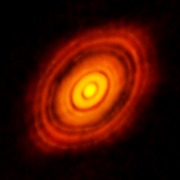HL Tauri
|
Star HL Tauri |
|||||
|---|---|---|---|---|---|

|
|||||
| Image of the stars HL Tauri (right above center, bluish) and XZ Tauri (left below center, reddish), surrounded by a molecular cloud , taken with the Hubble Space Telescope | |||||
| AladinLite | |||||
|
Observation dates equinox : J2000.0 , epoch : J2000.0 |
|||||
| Constellation | bull | ||||
| Right ascension | 04 h 31 m 38.44 s | ||||
| declination | + 18 ° 13 ′ 57.7 ″ | ||||
| Apparent brightness | 15.1 mag | ||||
| Typing | |||||
| B − V color index | 0.92 | ||||
| Spectral class | K5 | ||||
| Variable star type | T Tauri | ||||
| Astrometry | |||||
| distance | 450 ly | ||||
| Proper movement | |||||
| Rec. Share: | +8.0 (± 6.0) mas / a | ||||
| Dec. portion: | −21.8 (± 5.8) mas / a | ||||
| Physical Properties | |||||
|
Other names and catalog entries |
|||||
|
|||||
HL Tauri (abbreviated HL Tau ) is a very young variable star of the T-Tauri type in the constellation Taurus , which is located in the Taurus molecular cloud and is about 450 light years from Earth. The luminosity and the effective temperature suggest an age of less than 100,000 years. With an apparent magnitude of 15.1 mag, it cannot be observed with the naked eye. It is surrounded by a protoplanetary disk with concentric dark areas where planets are likely to form. Polar jets on this disk form the Herbig-Haro object HH 150 .
Image of the Herbig-Haro object HH 151 using the Hubble Space Telescope in visible light; the ionized atoms of the jet are highlighted in purple through line filters .
Interferometric image of the ALMA observatory of the submillimeter wave emission; the side length corresponds to 1.8 arc seconds .
Web links
- astronews.com: Details of a protoplanetary disk November 6, 2014
- astronews.com: Planetary embryo around HL Tauri March 18, 2016
Individual evidence
- ↑ a b c d HL Tauri . Retrieved August 27, 2018.
- ↑ a b Johnathan Webb: Planet formation captured in photo . In: BBC News , November 6, 2014.
- ↑ Woojin Kwon, Leslie W. Looney, Lee G. Mundy: Resolving the Circumstellar Disk of HL Tauri at Millimeter Wavelengths . In: The Astrophysical Journal . 741, No. 1, November 2011. arxiv : 1107.5275 . bibcode : 2011ApJ ... 741 .... 3K . doi : 10.1088 / 0004-637X / 741/1/3 .
- ^ David A. Weintraub, Joel H. Kastner, Barbara A. Whitney: In Search of HL Tauri . In: The Astrophysical Journal Letters . 452, October 1995, pp. L141-L145. bibcode : 1995ApJ ... 452L.141W . doi : 10.1086 / 309720 .
- ↑ Ian W. Stephens, Leslie W. Looney, Woojin Kwon, Manuel Fernández-López, A. Meredith Hughes, Lee G. Mundy, Richard M. Crutcher, Zhi-Yun Li: Spatially resolved magnetic field structure in the disk of a T Tauri star . In: Nature . 514, No. 7524, October 2014, pp. 597-599. arxiv : 1409.2878 . bibcode : 2014Natur.514..597S . doi : 10.1038 / nature13850 .
- ^ AP Boss, GE Morfill, WM Tscharnuter: Models of the Formation and Evolution of the Solar Nebula . In: SK Atreya, JB Pollack, MS Matthews (eds.): Origin and Evolution of Planetary and Satellite Atmospheres . The University of Arizona Press, 1989, ISBN 978-0-8165-1105-1 , page 45, bibcode : 1989oeps.book ..... A .
- ^ Charles E. Blue: Birth of Planets Revealed in Astonishing Detail in ALMA's 'Best Image Ever' . National Radio Astronomy Observatory. November 6, 2014. Archived from the original on November 6, 2014. Info: The archive link was inserted automatically and has not yet been checked. Please check the original and archive link according to the instructions and then remove this notice. Retrieved November 6, 2014.
- ↑ Max Planck Society: Planet birth in a hurry
- ^ Jets, bubbles, and bursts of light in Taurus . European Space Agency. November 6, 2014. Photo release Heic1424. Retrieved November 7, 2014.
- ↑ A jet from a glowing youngstar . European Space Agency. February 18, 2013. Photo release Potw1307a. Retrieved November 10, 2014.

